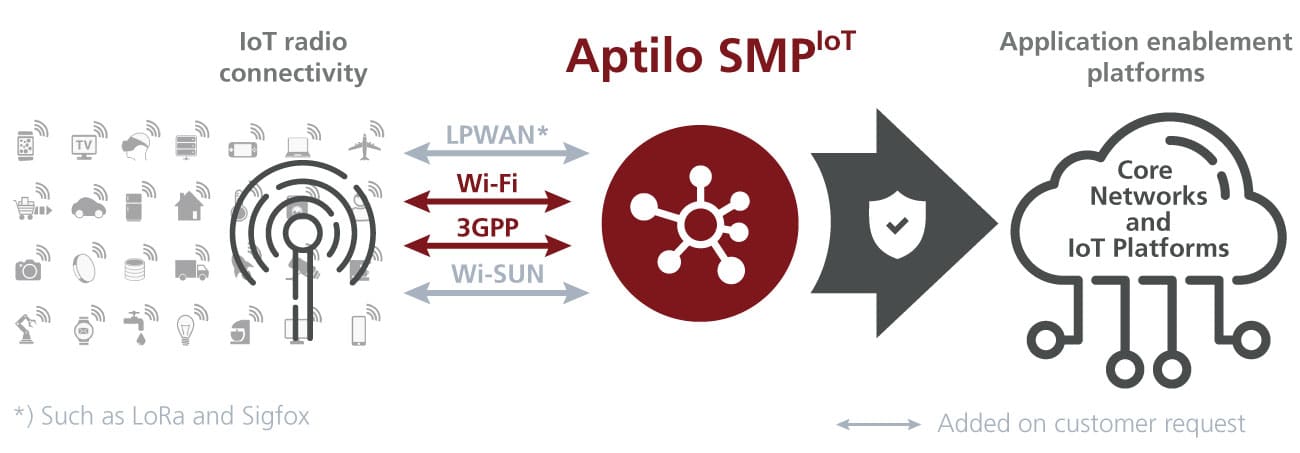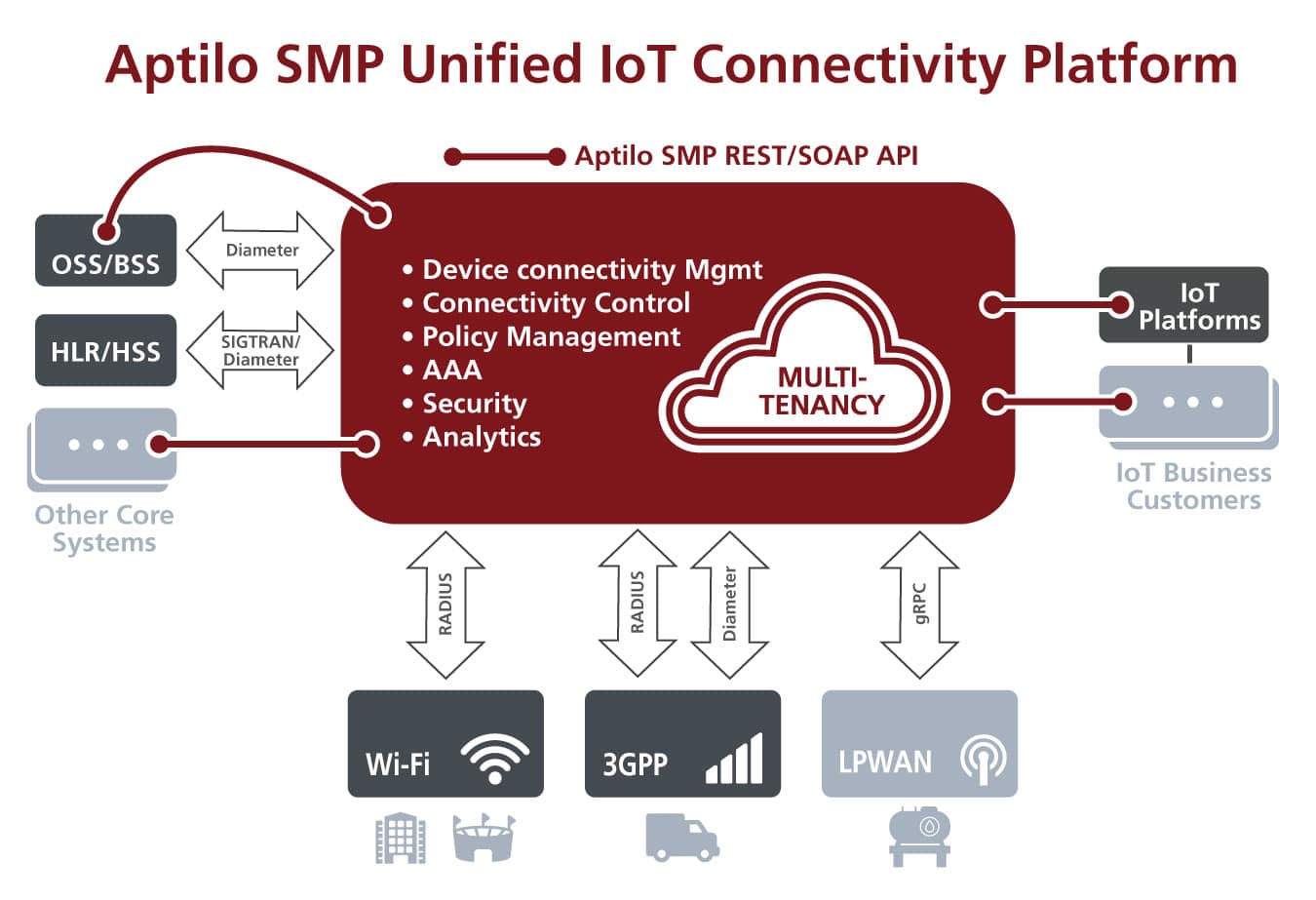multiple radio technologies
Unified IoT Connectivity Management Platform
The Enea Aptilo IoT SMP (SMPIoT) connectivity management platform provides unified IoT connectivity control across multiple radio technologies. It is based on the same Aptilo Service Management Platform™ (SMP) as the award-winning Aptilo SMP for Wi-Fi and features a scalable and flexible architecture. The Aptilo SMP has already been proven in over 100 demanding carrier Wi-Fi deployments and works as a policy control function (PCRF/PCF) for cellular services at mobile operators such as 3Scandinavia.

The award-winning new service for mobile operators, Enea Aptilo IoT Connectivity Control Service™ (IoT CCS), is based on Aptilo SMPIoT and IoT security from Fortinet. It provides a unique and programmable hyperscale IoT connectivity management layer for mobile operators that want to innovate in the IoT era.
There are many good IoT application enablement platforms in the market today. They all need to onboard and communicate with devices using different IoT connectivity radio technologies. Low-power wide-area network (LPWAN) radio technologies such as LoRa and Sigfox. 3GPP-based LPWAN such as NB-IoT. Mesh-based IoT radio technologies such as Wi-SUN. And more than anything else, short-range IoT connectivity such as Wi-Fi, Bluetooth, and ZigBee. In fact, according to Ericsson’s November 2021 mobility report, an astonishing 80% (or 24.3 billion devices) of all IoT devices in 2027 will use short-range radio technologies such as Wi-Fi. No wonder, as most things are not moving.
IoT Connectivity Management Platform in the Cloud
Although service providers can host the Aptilo IoT Connectivity Management Platform in their data centers, we primarily offer, or platform as a service hosted on Amazon Web Services (AWS). Currently, we offer two groundbreaking IoT connectivity control services.
Enea Aptilo IoT CCS – Because You Don’t Need Another Mobile Core
The Enea Aptilo IoT Connectivity Control Service™ (IoT CCS) is a groundbreaking IoT connectivity management service for mobile operators that want to innovate in the IoT era. They can leave their Mobile Core untouched and create cellular IoT connectivity services previously considered unthinkable.
Enea Aptilo Zero-Touch Wi-Fi IoT – a Game-Changer in Wi-Fi-Based IoT
Are you using AWS IoT Core to enable your IoT applications and finding it tiresome to manually onboard Wi-Fi IoT devices to a secure Wi-Fi network? Check out the Enea Aptilo Zero-touch Wi-Fi IoT Connectivity, our service on Amazon AWS for zero-touch Wi-Fi IoT onboarding. The same principles we use with AWS IoT Core can also be used for other IoT platforms.
Robust High Performance IoT Connectivity Management
Aptilo’s IoT connectivity management platform is designed to meet service providers’ requirements for a carrier-grade, scalable architecture with high availability. This includes geographical redundancy and disaster recovery. Whether you are a service provider with extremely high traffic volumes or an organization with lower use, you can always trust that Aptilo SMPIoT and Enea will deliver.
Future-Proof Your IoT Connectivity Needs
B2B or B2C or B2B2C, we do not care. Aptilo’s IoT connectivity platform works for every business model, and the flexibility will support your business regardless of your end customers. The Aptilo SMP IoT platform is built around our API-adapter concept and our service logic engine, which we call Aptilo ServiceGlue. It features a powerful rules engine with configurable logic, helping you intelligently enable IoT connectivity for different IoT applications for yourself or your customers.
Multitenant Platform
Our IoT connectivity platform is designed from the ground up to provide a multitenant solution to the service provider. A tenant represents the highest level of an organization utilizing the platform. Many tenants, e.g., the operator’s business customers, can share the platform and get access to their private functions and analytics.
The operator can scale our IoT connectivity platform to support thousands of tenants and many different services, reducing installation and operations costs and shortening timelines when onboarding new users and new devices.
Multitenancy means that:
- Multiple tenants share the same device database, with the data kept separated.
- Policy rules can be defined to apply to specific tenants only.
- Analytics are hierarchically provided per tenant to give each tenant a complete view of their events and services at any given level in the organization.
- The device onboarding maps into the tenant structure.
A Deeper Dive into Enea Aptilo SMPIoT
The keyword here is “unified.” Our IoT Connectivity Platform serves as a glue between IoT devices using different radio technologies, currently Cellular and Wi-FI, and IoT application enablement platforms such as AWS IoT Core, other cloud-based platforms, and operators’ IoT platforms. If you are a service provider, we can “glue in” your core systems as well. We do that over standard interfaces such as RADIUS, SIGTRAN, and Diameter or through our flexible REST API and can then connect to your own or third-party IoT platforms. The REST API can also be used to integrate different enterprise systems.
For Wi-Fi IoT connectivity, we recommend the secure and seamless EAP authentication methods EAP-SIM/AKA, EAP-TLS, and EAP-TTLS. These are one of the cornerstones in Passpoint (Hotspot 2.0) but also work with older Wi-Fi networks supporting 802.1x. This provides a Wi-Fi connectivity as secure as any cellular connection, as 802.1x encrypts the Wi-Fi radio network. MAC authentication is also possible, which provides a seamless connection, although less secure and without encryption. For a more secure and seamless user experience, explore the Enea Aptilo Zero-touch Wi-Fi IoT onboarding concept that utilizes the existing device certificates.
After having connected hundreds of millions of people and devices since 2001, our experience is that it is often not enough with a standard authentication. Many times you need intelligent connectivity. A connectivity that can look up policies in other subsystems to connect the device in the desired way. This is, in particular, true for IoT devices. Using the flexibility in our advanced policy engine, the Aptilo ServiceGlue™, we can do magic beyond the standards. We can, for instance, make a halt during the authentication and authorization process. Then look up policy information from multiple sources, form a new connectivity policy based on this information, and connect the device according to this policy.
